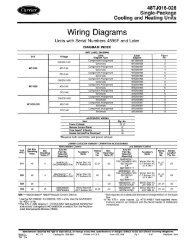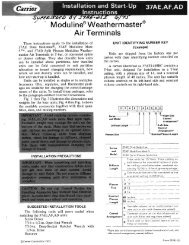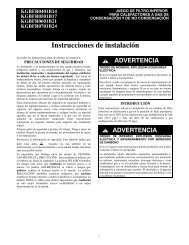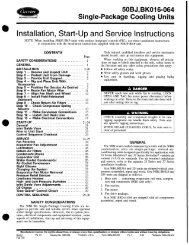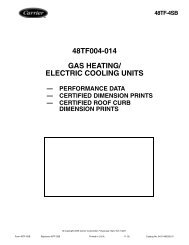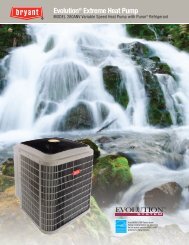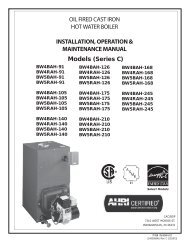Start-Up, Operation, and Maintenance Instructions
Start-Up, Operation, and Maintenance Instructions
Start-Up, Operation, and Maintenance Instructions
You also want an ePaper? Increase the reach of your titles
YUMPU automatically turns print PDFs into web optimized ePapers that Google loves.
Chiller Control Module (CCM) (Fig. 41)<br />
INPUTS — Each input channel has 2 or 3 terminals. Refer to<br />
individual chiller wiring diagrams for the correct terminal<br />
numbers for your application.<br />
OUTPUTS — Output is 24 vac. There are 2 terminals per output.<br />
Refer to the chiller wiring diagram for your specific application<br />
for the correct terminal numbers.<br />
Integrated <strong>Start</strong>er Module (Fig. 42)<br />
INPUTS — Inputs on strips J3 through J6 are analog inputs<br />
<strong>and</strong> J2 is discrete (on/off) input. The specific application of the<br />
chiller determines which terminals are used. Refer to the individual<br />
chiller wiring diagram for the correct terminal numbers<br />
for your application.<br />
OUTPUTS — Outputs are 115-277 vac <strong>and</strong> wired to strip J9.<br />
There are 2 terminals per output.<br />
Replacing Defective Processor Modules —<br />
The module replacement part number is printed on a small<br />
label on the rear of the CVC/ICVC module. The chiller model<br />
<strong>and</strong> serial numbers are printed on the chiller nameplate located<br />
on an exterior corner post. The proper software is factoryinstalled<br />
by Carrier in the replacement module. When ordering<br />
a replacement chiller visual control (CVC/ICVC) module,<br />
specify the complete replacement part number, full chiller<br />
model number, <strong>and</strong> chiller serial number. The installer must<br />
configure the new module to the original chiller data. Follow<br />
the procedures described in the Software Configuration section<br />
on page 55.<br />
Electrical shock can cause personal injury. Disconnect all<br />
electrical power before servicing.<br />
INSTALLATION<br />
1. Verify the existing CVC/ICVC module is defective by using<br />
the procedure described in the Troubleshooting Guide<br />
section, page 76, <strong>and</strong> the Control Modules section,<br />
page 87. Do not select the ATTACH TO NETWORK<br />
DEVICE table if the CVC/ICVC indicates a communication<br />
failure.<br />
2. Data regarding the CVC/ICVC configuration should have<br />
been recorded <strong>and</strong> saved. This data must be reconfigured<br />
into the new CVC/ICVC. If this data is not available, follow<br />
the procedures described in the Software Configuration<br />
section.<br />
If a CCN Building Supervisor or Service Tool is available,<br />
the module configuration should have already been<br />
uploaded into memory. When the new module is installed,<br />
the configuration can be downloaded from the<br />
computer.<br />
Any communication wires from other chillers or CCN<br />
modules should be disconnected to prevent the new<br />
CVC/ICVC module from uploading incorrect run hours<br />
into memory.<br />
3. To install this module, record values for the TOTAL<br />
COMPRESSOR STARTS <strong>and</strong> the COMPRESSOR<br />
ONTIME from the MAINSTAT screen on the CVC/<br />
ICVC.<br />
4. Power off the controls.<br />
5. Remove the old CVC/ICVC.<br />
6. Install the new CVC/ICVC module. Turn the control<br />
power back on.<br />
88<br />
7. The CVC/ICVC now automatically attaches to the local<br />
network device.<br />
8. Access the MAINSTAT table <strong>and</strong> highlight the TOTAL<br />
COMPRESSOR STARTS parameter. Press the SELECT<br />
softkey. Increase or decrease the value to match the starts<br />
value recorded in Step 3. Press the ENTER softkey<br />
when you reach the correct value. Now, move the highlight<br />
bar to the COMPRESSOR ONTIME parameter.<br />
Press the SELECT softkey. Increase or decrease the run<br />
hours value to match the value recorded in Step 2. Press<br />
the ENTER<br />
softkey when the correct value is reached.<br />
9. Complete the CVC/ICVC installation. Following the instructions<br />
in the Input Service Configurations section,<br />
page 55, input all the proper configurations such as the<br />
time, date, etc. Check the pressure transducer calibrations.<br />
PSIO installation is now complete.<br />
Solid-State <strong>Start</strong>ers — Troubleshooting information pertaining<br />
to the Benshaw, Inc., solid-state starter may be found<br />
in the following paragraphs <strong>and</strong> in the Carrier Redi<strong>Start</strong><br />
MICRO Instruction Manual supplied by the starter vendor.<br />
Attempt to solve the problem by using the following preliminary<br />
checks before consulting the troubleshooting tables found<br />
in the Benshaw manual.<br />
1. Motor terminals or starter output lugs or wire should<br />
not be touched without disconnecting the incoming<br />
power supply. The silicon control rectifiers (SCRs)<br />
although technically turned off still have AC mains<br />
potential on the output of the starter.<br />
2. Power is present on all yellow wiring throughout the<br />
system even though the main circuit breaker in the<br />
unit is off.<br />
With power off:<br />
Inspect for physical damage <strong>and</strong> signs of arcing, overheating,<br />
etc.<br />
Verify the wiring to the starter is correct.<br />
Verify all connections in the starter are tight.<br />
Check the control transformer fuses.<br />
TESTING SILICON CONTROL RECTIFIERS IN THE<br />
BENSHAW, INC., SOLID-STATE STARTERS — If an SCR<br />
is suspected of being defective, use the following procedure as<br />
part of a general troubleshooting guide.<br />
1. Verify power is applied.<br />
2. Verify the state of each SCR light-emitting diode (LED)<br />
on the micropower card.<br />
NOTE: All LEDs should be lit. If any red or green side of<br />
these LEDs is not lit, the line voltage is not present or one<br />
or more SCRs has failed.<br />
3. Check incoming power. If voltage is not present check<br />
the incoming line. If voltage is present, proceed to Steps 4<br />
through 11.<br />
NOTE: If after completing Steps 4 - 11 all measurements<br />
are within specified limits, the SCRs are functioning normally.<br />
If after completing Steps 4 - 11 resistance measurements<br />
are outside the specified limits, the motor leads on<br />
the starter power lugs T1 through T6 should be removed<br />
<strong>and</strong> the steps repeated. This will identify if abnormal resistance<br />
measurements are being influenced by the motor<br />
windings.<br />
4. Remove power from the starter unit.







